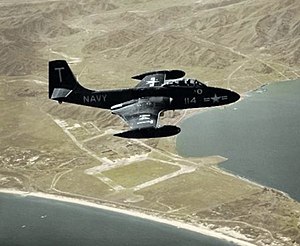F2H Banshee
| F2H Banshee | |
|---|---|
 |
|
| A US Navy F2H-2 Banshee over Wonsan, North Korea, 1952 | |
| Role | Carrier-based fighter aircraft |
| National origin | United States |
| Manufacturer | McDonnell Aircraft |
| First flight | 11 January 1947 |
| Introduction | August 1948 |
| Retired | 30 September 1959 USN 1959 USMC 1960 USN, USMC (F2H-2P) 1961 USNR, USMCR 12 September 1962 RCN |
| Status | Phased out of service |
| Primary users |
United States Navy United States Marine Corps Royal Canadian Navy |
| Number built | 895 |
| Developed from | McDonnell FH Phantom |
The McDonnell F2H Banshee was a single-seat carrier-based jet fighter aircraft deployed by the United States Navy and United States Marine Corps from 1948 to 1961. It was one of the primary American fighters used during the Korean War and was the only jet-powered fighter ever deployed by the Royal Canadian Navy, serving the RCN from 1955 until 1962. The aircraft's name is derived from the banshee of Irish mythology.
The Banshee was a development of the FH Phantom, although it was being planned before the Phantom went into production. McDonnell engineers originally intended the aircraft to be a modified Phantom that shared many parts with the earlier aircraft, but it soon became clear that the need for heavier armament, greater internal fuel capacity, and other improvements would make the idea unfeasible.
The new aircraft would use much larger and more powerful engines, a pair of newly developed Westinghouse J34 turbojets, raising thrust from the J30's 1,600 lbf (7 kN) to 3,000 lbf (13 kN) each; since the larger engines had to fit within the wing roots, this required a larger and thicker wing with a span of 41 ft 6 in (12.65 m) rather than the Phantom’s span of 40 ft 0 in (12.19 m). The more powerful engines also used more fuel, so the fuselage was enlarged and strengthened to increase fuel capacity. Navy leaders decided to move away from the World War II standard .50-caliber (12.7 mm) machine gun to 20 mm (0.79 in) ; four of the guns were mounted low on the nose to prevent pilots from being blinded by muzzle flash when firing the guns at night, a problem that vexed the Phantom with its top-mounted guns. The Banshee was designed to accommodate an ejection seat, a capability the Phantom lacked, and it incorporated a large number of improvements to other aircraft systems. The cockpit was fully pressurized and air-conditioned, and the flaps, landing gear, folding wings, canopy, and air brakes were electrically rather than pneumatically operated. The front of the canopy was made of bulletproof glass that was electrically heated to prevent frost.
...
Wikipedia
